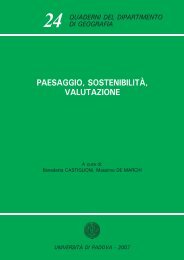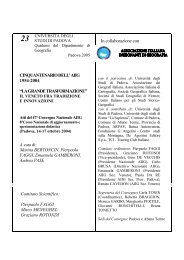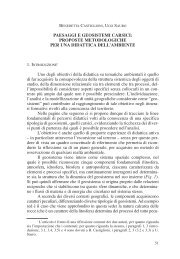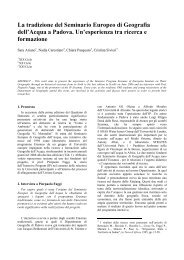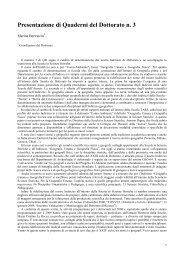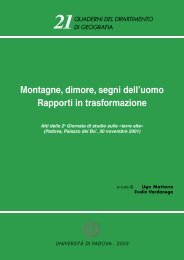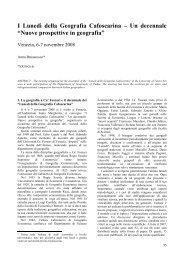Le discariche nel Veneto - Università degli Studi di Padova
Le discariche nel Veneto - Università degli Studi di Padova
Le discariche nel Veneto - Università degli Studi di Padova
You also want an ePaper? Increase the reach of your titles
YUMPU automatically turns print PDFs into web optimized ePapers that Google loves.
alluvionale veneta, dalla sua linea <strong>di</strong> risorgive <strong>nel</strong>la sua<br />
zona pedemontana alla laguna <strong>di</strong> Venezia è<br />
particolarmente fragile per la presenza <strong>degli</strong> acquiferi<br />
affioranti. D’altro canto, il territorio veneto, che è<br />
costantemente stimolato a <strong>di</strong>versi stress ambientali, sia<br />
attraverso l’estensione delle sue zone industriali e la<br />
moltiplicazione delle attività commerciali, sia<br />
attraverso la <strong>di</strong>ffusione del suo tessuto urbano, risulta<br />
oggi come una delle aree più sensibili al rischio<br />
ambientale. In più, la presenza <strong>di</strong> Venezia e i numerosi<br />
progetti ideati per proteggere la Serenissima e la sua<br />
laguna hanno conseguenze notevoli sul suo hinterland.<br />
La <strong>di</strong>namica dei rifiuti è oggi al centro delle<br />
preoccupazioni pubbliche e la riabilitazione dell’area<br />
industriale <strong>di</strong> Marghera (non compresa <strong>nel</strong>la nostra<br />
zona <strong>di</strong> stu<strong>di</strong>o perché considerata da sola come una<br />
<strong>di</strong>scarica a cielo aperto) è un intervento necessario data<br />
la fonte <strong>di</strong> inquinamento che rappresentava. Inoltre, i<br />
progetti <strong>di</strong> bonifica <strong>di</strong> vecchie <strong><strong>di</strong>scariche</strong> contaminanti,<br />
oppure <strong>di</strong> cave riempite in maniera abusiva,<br />
permettono <strong>di</strong> valutare il rischio e <strong>di</strong> risanare un<br />
territorio sofferente.<br />
Bibliografia<br />
Allgaier G. and Stegmann R. (2006), “Old landfills in<br />
the focus of the urban land management”, Workshop<br />
Tecnologie per la riduzione <strong>degli</strong> impatti e la<br />
bonifica delle <strong><strong>di</strong>scariche</strong>, Montegrotto Terme<br />
(<strong>Padova</strong>), 10 pp.<br />
Carter G. A. (1993), “Response of leaf spectral<br />
reflectance to plant stress”, American Journal of<br />
Botany, 80, n. 3, pp. 239-243.<br />
Cenedese A., Miozzi M., Benettazzo A., Paglialunga<br />
A., Daquino C., Mussapi R. (2003), “Vegetation<br />
cover analysis using a low budget hyperspectral<br />
proximal sensing system”, Procee<strong>di</strong>ngs of the<br />
workshop on Airborne Remote Sensing for<br />
Geophysical and Environmental Application, CNR<br />
headquarters, Rome, Italy.<br />
Del Pero G., Ferroni P., Marino C.M., Ronzoni M.<br />
(1995), “Utilizzo dello scanner iperspettrale MIVIS<br />
per il monitoraggio <strong>di</strong> ambienti <strong>di</strong> <strong>di</strong>scarica”, Atti<br />
del VII Convegno Nazionale AIT.<br />
Fior F., Rosselli R., Silvestri S., Biotto G., Furlan E.,<br />
Gobbo L., Omri M., Valenti S., Rampazzo S.,<br />
Nicoletti V., Buzzino C., Beltrame P., Dal Tin M.,<br />
Bellomo A., Beghi S. (2005), “The use of remote<br />
sensing and GIS to map illegal dumps: a project<br />
sponsored by the <strong>Veneto</strong> Region”, SARDINIA Tenth<br />
International Waste Management and landfill<br />
symposium, procee<strong>di</strong>ngs 476, pp.689-690.<br />
Gomarasca M.A., Strobelt S. (1995), “Integrazione <strong>di</strong><br />
dati TM e MIVIS per l’in<strong>di</strong>viduazione <strong>di</strong><strong><strong>di</strong>scariche</strong>”,<br />
Atti del VII Convegno Nazionale AIT.<br />
Johnson E., Klein M., Mickus K. (1993), “Assessment<br />
of the feasibility of utilizing Landsat for detection<br />
and monitoring of landfills in a statewide GIS”,<br />
Environmental geology, 22, n.2, pp. 129-140.<br />
Kumar L., Schmidt K.S., Dury S. & Skidmore A.K.<br />
(2001), “Review of Hyperspectral Remote Sensing<br />
and Vegetation Science”, in Van Der Meer,<br />
Hyperspectral Remote Sensing, Kluwer Academic<br />
Press, Dordrecht.<br />
Mather P. M. (1999), Computer Processing of<br />
Remotely-Sensed Images. An introduction, John<br />
Wiley & Sons, Baffins Lane, Chichester (England),<br />
292 pp.<br />
NASA (2005), AERONET website<br />
http://aeronet.gsfc.nasa.gov<br />
Omri M., Silvestri S., Rosselli R., Mering C. (2005),<br />
“Methods to <strong>di</strong>scriminate waste material dumps<br />
through remote sensing: a comparison analysis”,<br />
SARDINIA Tenth International Waste Management<br />
and landfill symposium, procee<strong>di</strong>ngs 477, pp. 1059-<br />
1060.<br />
Pitea D., De Cesaris A.L., Marchetti G. (1997),<br />
“In<strong>di</strong>viduazione, caratterizzazione e campionamento<br />
<strong>di</strong> ammassi abusivi <strong>di</strong> rifiuti pericolosi”, in<br />
Fondazione Lombar<strong>di</strong>a per l’ambiente,<br />
Valorizzazione dei progetti <strong>di</strong> ricerca 1994/1997.<br />
Reusen I., Bertels L., Debruyn W., Deronde B.,<br />
Fransaer D., Stercks (2000), “Species Identification<br />
and Stress Detection of Heavy-Metal Contaminated<br />
Trees”, VITO-Flemish Institute for Technological<br />
Research, Mol, Belgium, 5 pp.<br />
Richter R. (2005), “Atmospheric / Topographic<br />
Correction for Satellite Imagery”, DLR report DLR-<br />
IB 565-01/05, Wessling, Germany, (website<br />
http://www.rese.ch/).<br />
Silvestri S., Omri M., Rosselli R. (2005), “The use of<br />
remote sensing to map illegal dumps in the <strong>Veneto</strong><br />
plain”, SARDINIA Tenth International Waste<br />
Management and landfill symposium, procee<strong>di</strong>ngs<br />
463, pp. 1057-1058.<br />
Vallerani, F., Varotto, M. (a cura <strong>di</strong>) (2005), Il grigio<br />
oltre le siepi: geografie smarrite e racconti del<br />
<strong>di</strong>sagio in <strong>Veneto</strong>, Università <strong>degli</strong> <strong>Stu<strong>di</strong></strong> <strong>di</strong> <strong>Padova</strong>,<br />
Dipartimento <strong>di</strong> Geografia “G. Moran<strong>di</strong>ni”, 298 pp.<br />
Vincent R.K. (1994), “Remote Sensing for Solid Waste<br />
Landfills and Hazardous Waste Sites”,<br />
Photogrammetric Engineering and Remote Sensing,<br />
60, n. b8, pp. 979-982.<br />
Zilioli E., Gomarasca M.A., Tomasoni R. (1992),<br />
“Application of Terrestrial Thermography to the<br />
Detection of Waste-Disposal Sites”, Remote Sensing<br />
of Environment, 40, pp. 153-160.<br />
Zhang Y. (2001), “A spectral and spatial information<br />
integrated approach for tree extraction from highresolution<br />
<strong>di</strong>gital imagery”, Procee<strong>di</strong>ngs of Digital<br />
Earth, Frederickson, NB, Canada.<br />
53



